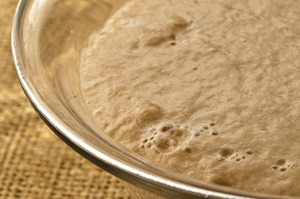Commercial Yeast (Hefe)
Yeast is basically a plant. More specifically it is a one-celled life form which digests sugars (such as sugars contained in the starch in flour) and produces alcohol (ethanol) and carbon dioxide. When used in baking, the ethanol evaporates while the carbon dioxide leavens, or raises, the dough.
Commercial yeast is grown and packaged under very strict hygenic regulations. Manufacturing companies have perfected the ability to grow yeast cells rapidly and keep them alive in both dry and moist form.
The following types of commercial yeast are available to the home baker.
Active Dry Yeast
Active dry yeast is grown on relatively large grains of nutrients that have to be dissolved first in warm water.
Unopened, active dry yeast stored at room temperature will last almost 12 months past the expiration date. It will keep longer if frozen. Place directly in the freezer in its vacuum sealed container. If frozen, you can use it directly without thawing.
If opened, active dry yeast will last 6 months in the refrigerator and 12 months in the freezer. Stored at room temperature and opened without a protective outer container it loses its power at about 10% per month.
Instant Yeast
Instant yeast comes on small grains of nutrient that instantly hydrates by the liquid in the dough, so it can be added directly to the flour. Instant yeast contains about 25% more living yeast cells per spoonful than active dry yeast.
Instant yeast will last about one year at room temperature if unopened. If opened, it will last 6 months in the refrigerator and 12 months in the freezer.
Fresh Yeast
Fresh yeast is is a form of yeast in which both the yeast and nutrient base are in a moist, paste form. Fresh yeast is available in some specialty and natural food store, but its shelf life is only 2 to 3 weeks.

Photo: © hjschneider - Fotolia.com |
|

Photo: © Jovan Nikolic- Fotolia.com

| As a general rule, if a recipe calls for one type of yeast, it is usually acceptable to substitute another type according to the following substitution ratio: |
| 100% fresh yeast |
| = |
| 50% active dry yeast |
| = |
| 33% instant yeast |
| |
| For example, if the recipe calls for fresh yeast and you have only active dry yeast, use half (50%) as much as the recipe calls for. So, if the recipe calls for 1 teaspoon fresh yeast, use only 1/2 teaspoon active dry yeast. |
| |

| 1 package active dry yeast = about 2 1/4 teaspoons = 1/4 ounce |
| |
| 1 (6-ounce) cube fresh yeast = 1 package of active dry yeast |
| |
| 1 package of instant yeast = 2 1/4 teaspoons= 1/4 ounce |
| |
| 1 (6-ounce) cube of fresh yeast = 1-1/2 to 2 teaspoons instant yeast |
| |
|

